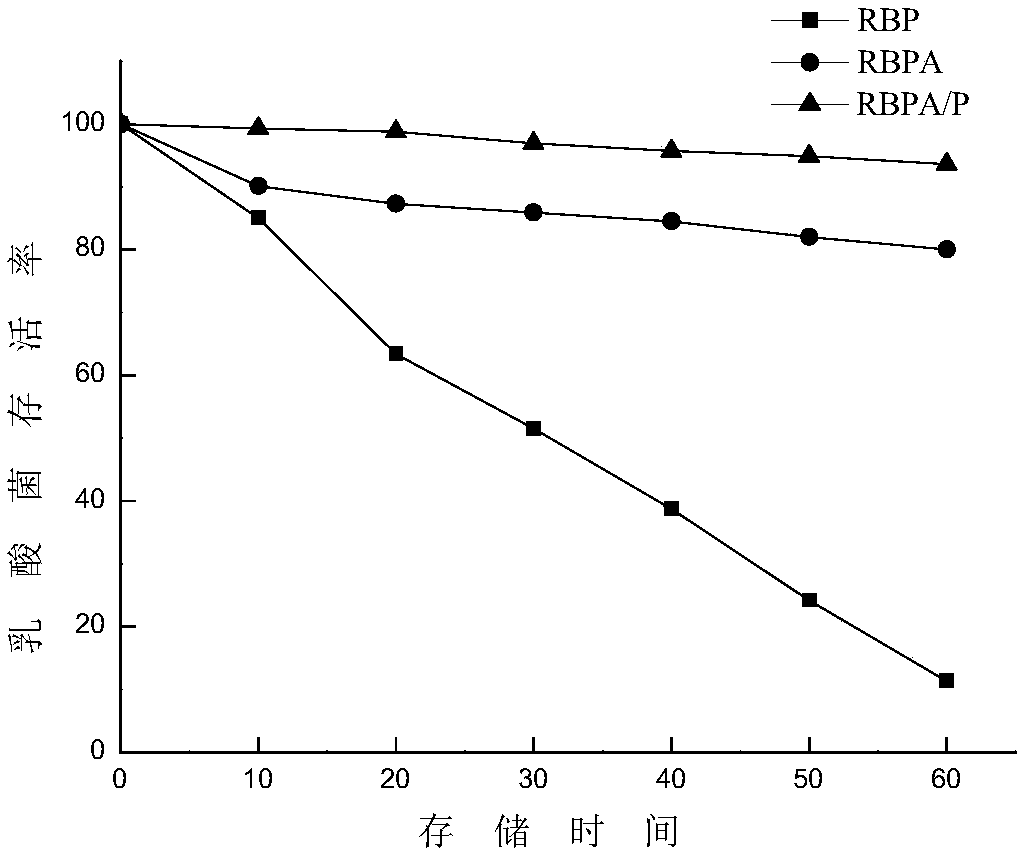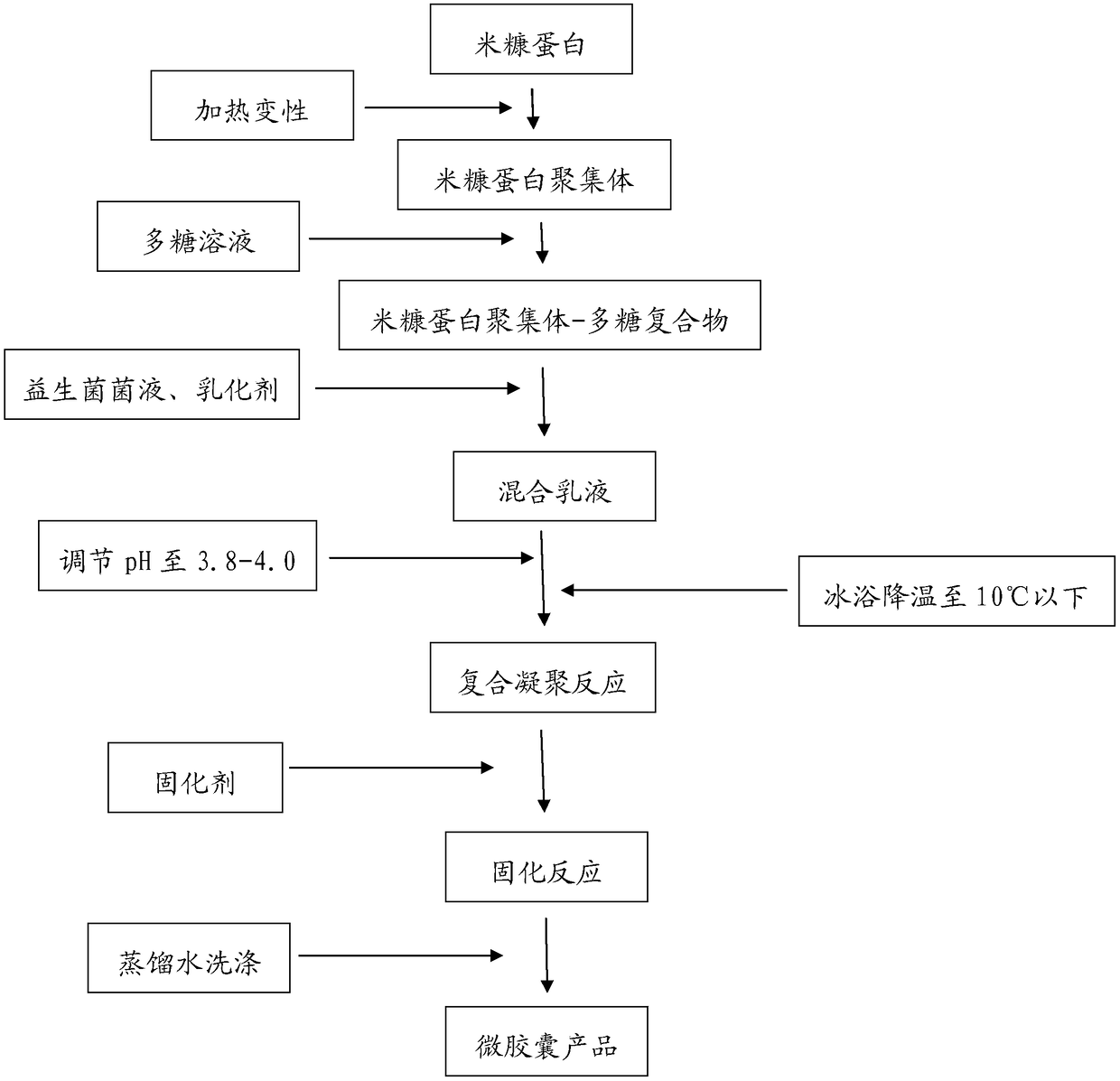Probiotic microcapsule with protein aggregate-polysaccharide as wall material and preparation method thereof
A technology of protein aggregates and microcapsules, which is applied in food forming, food ingredients as encapsulants, food science, etc., can solve the problems of natural protein instability and affect applications, and achieve high survival rate, good acid resistance and Effect of enteric solubility and uniform particle size distribution
- Summary
- Abstract
- Description
- Claims
- Application Information
AI Technical Summary
Problems solved by technology
Method used
Image
Examples
Embodiment 1
[0022] (1) Activation and cultivation of strains: the freeze-dried powder of lactic acid bacteria stored in the laboratory was inserted into an aqueous solution of 11% skim milk, and subjected to anaerobic constant temperature cultivation at 37° C. for 24 hours, and the skim milk solidified. Dilute 0.1mL curd with sterile water to prepare a suspension containing lactic acid bacteria. Separation of the bacterial suspension by streaking on a plate, anaerobic culture at 37°C for 24 hours, and continuous passage for 2-3 times in this way to fully activate it. Inoculate the activated lactic acid bacteria liquid into the MRS liquid medium, and after anaerobic constant temperature cultivation at 37°C to the logarithmic phase, centrifuge the obtained bacterial liquid at 4°C and 8000rmp for 10min, discard the supernatant, and collect the bacteria body.
[0023] (2) Configuration of microcapsule wall material solution: rice bran protein solution with a mass percentage of 15%
[0024] ...
Embodiment 2
[0028] Microcapsule preparation method is the same as example 1, change microcapsule wall material solution: rice bran protein aggregate solution
[0029] Preparation of rice bran protein aggregate solution: Dissolve a certain amount of rice bran protein in distilled water with a mass percentage of 15% and stir for 2 hours to ensure that the rice bran protein can be completely hydrolyzed, adjust the pH of the rice bran protein solution to 2, and collect the supernatant after centrifugation solution, and then heated and denatured in a water bath at 90°C for 2 hours, and then cooled rapidly in an ice bath to prevent the growth of aggregates to form a solution of rice bran protein aggregates.
[0030] The embedding rate of the obtained lactic acid bacteria microcapsules reaches 75% + 1.1%. 12 CFU / g.
Embodiment 3
[0032] Microcapsule preparation method is the same as example 1, change microcapsule wall material solution: the solution+polysaccharide solution of rice bran protein aggregate (gum arabic, dextran, chitosan)
[0033]Preparation of rice bran protein aggregate solution: Dissolve a certain amount of rice bran protein in distilled water with a mass percentage of 15%, stir for 2 hours to ensure that the rice bran protein can be completely hydrolyzed, adjust the pH of the rice bran protein solution to 2, and collect it after centrifugation The supernatant solution was heated and denatured in a water bath at 90°C for 2 hours, and after taking it out, it was quickly cooled in an ice bath to prevent the growth of aggregates, and the formed rice bran protein aggregate solution was ready for use;
[0034] The configuration of the microcapsule wall material solution: add 2% polysaccharide solution dropwise to the prepared rice bran protein aggregate solution according to the ratio (polysa...
PUM
 Login to View More
Login to View More Abstract
Description
Claims
Application Information
 Login to View More
Login to View More - R&D
- Intellectual Property
- Life Sciences
- Materials
- Tech Scout
- Unparalleled Data Quality
- Higher Quality Content
- 60% Fewer Hallucinations
Browse by: Latest US Patents, China's latest patents, Technical Efficacy Thesaurus, Application Domain, Technology Topic, Popular Technical Reports.
© 2025 PatSnap. All rights reserved.Legal|Privacy policy|Modern Slavery Act Transparency Statement|Sitemap|About US| Contact US: help@patsnap.com



